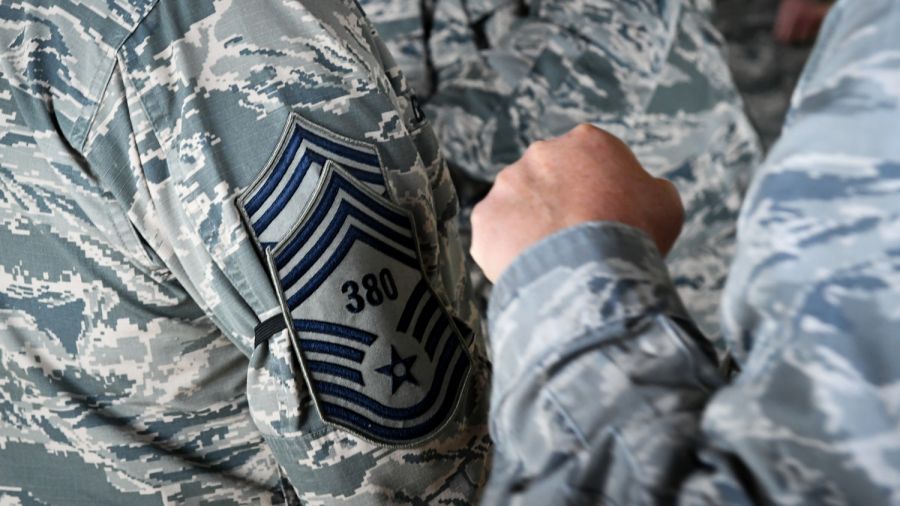Air Force Adopts ‘Indefinite Enlistment’ for NCOs
The newest branch of the US Armed Forces has made a long-overdue policy change that others should copy.

No longer will Air Force non-commissioned officers with at least twelve years of service have to re-enlist. Instead, they’ll simply remain on active duty until they decide to leave or are forced to retire.
Brian Everstine reports for Air Force magazine:
Airmen who have served for 12 years or more no longer have to re-enlist under a change made official Oct. 30.
Previously, senior enlisted airmen were required to re-enlist every four years, a process described as lengthy and full of cumbersome paperwork that culminated in raising their right hand at a swearing-in ceremony.
Now, under a new Noncommissioned Officer Career Status Program, that requirement is gone. Instead, an Oct. 30 Air Force release said, their separation dates will align with their high year of tenure date—when they must separate or retire.
Effective Nov. 18, airmen with at least 12 years of service who sign a re-enlistment contract will fall under the program, and it will be the last contract of their career. There will no longer be a date of separation on their records until they hit one year until their mandatory separation or retirement date. When promoted, the date of separation will automatically be updated, the release stated.
While there is a certain ritualistic value in publicly reaffirming their commitment to serve, it’s an enormous administrative burden for the services to keep all of this paperwork processed. Further, it sends the message that non-commissioned officers are the temporary help, while their commissioned counterparts are the permanent professionals. While that may have been true generations ago, it’s not any longer.
As with commissioned officers, there’s an up-or-out system but it’s not particularly onerous:
Current high year of tenure lengths are:
-20 years for staff sergeants,
-22 years for technical sergeants,
-24 years for master sergeants,
-26 years for senior master sergeants, and
-30 years for chief master sergeants.
For reasons I’ve forgotten, the Air Force is one off the rank structure of the Army from which it broke away in 1947, so their staff sergeants are pay grade E-5, a rank attainable in one’s first enlistment. It’s rare to put in 20 years and not make it to at least E-7, the master sergeant rank. (Again, Army master sergeants are pay grade E-8.)
I had missed the news that the Army has already done this:
The Army already has the same process in place for soldiers with 12 years of service.
The Navy and Marine Corps should follow suit.
The release itself answers the most obvious question:
“Career Airmen are consummate professionals who have demonstrated their commitment to service,” said Lt. Gen. Brian Kelly, Air Force deputy chief of staff for manpower, personnel and services. “They play a crucial role in developing the next generation of Airmen. With this adjustment, we’re providing them the associated flexibility to make individualized career decisions.”
Airmen who reenlist under the NCO Career Status Program will follow processes similar to those of officers and will incur active duty service commitments.
So, yes, Air Force NCOs will simply be able to resign from the service in the same way its officers do.




I wondered about this as I approached my first reenlistment lo, those many years ago. I’m also unsure why there’s any value in waiting until twelve years of service for this to kick in.
@Boyd: Twelve years does seem too late. I could see the value of 3- and 4-year enlistments for the first couple of terms before essentially guaranteeing them a long-term career. But, certainly, upon reaching E-6, I think career status should kick in.
For officers, 0-2 (1st lieutenant/lieutenant junior grade) is essentially automatic and, depending on the year group, so is 0-3 (USA, USMC, USAF captain and Navy lieutenant). Absent a massive manpower need, since as during the height of GWOT, we cull the herd significantly with the selection to 0-4 (major/lieutenant commander) around the 10-year mark.
Are re-enlistment bonuses no longer a thing?
@Michael Reynolds: Good point, but that just means the services would have to adjust their incentive programs to match the retention approach. Also, at least during my time in uniform, re-enlistment bonuses were heavily (if not exclusively) focused on the first and, to a lesser degree, second re-enlistment contracts.
@James Joyner: During my time in the Navy, the enlistment contract was never used to reduce manpower, but instead to balance specialty resources with the service’s current needs. But I do agree, from my distant and unenlightened perspective, that permanence would be better based on rank rather than time in service.
Another advantage of this system is it gets rid of all the “box-checking” required for reenlistments, which can sometimes throw a wrench into the cogs. It also denies the ability of Commands to use reenlistment denials as an easy alternative to disciplinary action.
I can’t remember exactly, but I think it’s because the Air Force made E-5 the first rank with NCO authority – unlike the other services which is E-4 in many cases.
E-5 is probably the norm for a 6-year first enlistment, it’s pretty rare in a 4-year enlistment because of time-in-service requirements.
@Michael Reynolds:
This won’t affect bonuses, they have another way to calculate them. However, bonuses are used as retention incentives for critical skills and grades and are primarily offered for first and second-term reenlistments. Generally, there aren’t shortages of long-term “career” NCO’s, so bonuses aren’t necessary – or offered – for career NCO’s in most cases.
@James Joyner:
This summer’s crop of AF Line officers was 98% promotion rate to Major and 71% to LTC. Promotion rates are still pretty high compared to 20 years ago when I was going up through the ranks.
And I remember pinning on Major at the 12 year point.
When I was in the USAF from 91 – 95, the highest you could get in your first 4 year enlistment was E-4 or Sr Airman. E-5 was Staff Sergeant; the first enlisted rank for which promotion depended on test scores/points. E-4 used to be split between Senior Airman and Sergeant depending on time in grade, but they dropped that before I was in.